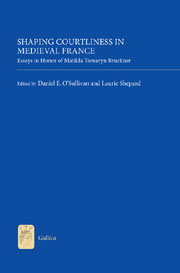Book contents
- Frontmatter
- Contents
- List of Illustrations
- Acknowledgements
- Introduction
- Matilda Tomaryn Bruckner: A Bibliography
- Part I Shaping Real and Fictive Courts
- Part II Shaping Courtly Narrative
- Part III Shaping Women's Voices in Medieval France
- Part IV Shaping the Courtly Other
- The Favorable Reception of Outsiders at Court: Medieval Versions of Cultural Exchange
- Shaping Saladin: Courtly Men Dressed in Silk
- Force de parole: Shaping Courtliness in Richard de Fournival's Bestiaire d'amours, Copied in Metz about 1312 (Oxford, Bodl. MS Douce 308)
- The Poetic Legacy of Charles d'Anjou in Italy: The Poetics of Nobility in the Comune
- Envoi
- List of Contributors
- Index
- Tabula Gratulatoria
- Already Published
Shaping Saladin: Courtly Men Dressed in Silk
from Part IV - Shaping the Courtly Other
Published online by Cambridge University Press: 05 May 2013
- Frontmatter
- Contents
- List of Illustrations
- Acknowledgements
- Introduction
- Matilda Tomaryn Bruckner: A Bibliography
- Part I Shaping Real and Fictive Courts
- Part II Shaping Courtly Narrative
- Part III Shaping Women's Voices in Medieval France
- Part IV Shaping the Courtly Other
- The Favorable Reception of Outsiders at Court: Medieval Versions of Cultural Exchange
- Shaping Saladin: Courtly Men Dressed in Silk
- Force de parole: Shaping Courtliness in Richard de Fournival's Bestiaire d'amours, Copied in Metz about 1312 (Oxford, Bodl. MS Douce 308)
- The Poetic Legacy of Charles d'Anjou in Italy: The Poetics of Nobility in the Comune
- Envoi
- List of Contributors
- Index
- Tabula Gratulatoria
- Already Published
Summary
Chrétien de Troyes's twelfth-century romance Perceval ou le Conte du Graal stages a telling encounter between the naïve and bumbling Perceval and his newfound chivalric mentor, Gornemont de Gort, in which the mentor asks, “Et de vos armes, biax amis, / Me redites que savez faire?” (1391–2), [Tell me again, my friend, what can you do with your arms/armor?]. Perceval responds curiously:
Jes sai bien vestir et retraire, Si com li vallés m'en arma Qui devant moi en desarma Le chevalier qu'avoie mort. (1392–5)
[I can put them on and remove them, just like the squire who armed me after disarming the knight I had slain.]
Perceval's seemingly silly reply appears at first to miss the point of Gornemont's inquiry. Instead of attesting to his skills as a knight, the newly dubbed Perceval can speak only of his skill at dressing and undressing as a knight.
And yet, Perceval's remarks aptly convey the importance of material culture, especially clothing, in the creation of chivalric masculinity within the Arthurian world. As Laurie A. Finke and Martin B. Shichtman have shown in Cinematic Illuminations (in which they analyze both Chrétien's text and the film version of it, “Perceval Le Gallois,” directed by Eric Rohmer), knights in King Arthur's realm have to perform chivalry constantly in order to maintain it.
- Type
- Chapter
- Information
- Shaping Courtliness in Medieval FranceEssays in Honor of Matilda Tomaryn Bruckner, pp. 241 - 254Publisher: Boydell & BrewerPrint publication year: 2013



